 |
 |
Falaise, William the Conqueror’s birthplace |
 |
 |
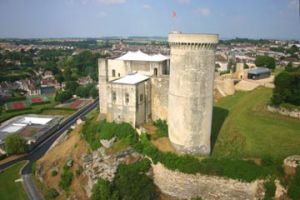
|
 © Château Guillaume-le-Conquérant © Château Guillaume-le-Conquérant

|
A powerful town in the Middle Ages, Falaise boasts several monuments bearing witness to its golden days. Thanks to augmented reality technology allowing tourists to see how the interior decoration once looked like, its impressive Anglo-Norman fortress is now a must-see.
[ Practical ]
Getting there
- By road
270 km from Paris on autoroute A13 till Caen then on N814 (Ring Road) till exit 13, then on Route de Falaise till exit 10 and on D 658 till Falaise.
- By train
Train from Paris Saint-Lazare to Caen. Journey takes approximately 2 hours. Then bus N° 35 from Caen to Falaise.
Lodging
- Hotels
Hôtel de la Poste
Hôtel Ibis
- Bed and breakfast
Les Bissons in Versainville (2 km away)
Domaine de la Tour in Saint-Pierre-Canivet (3 km away)
Restaurants
La Fine Fourchette
L’Attache
Hôtel de la Poste
Le Jardin
L’Estaminet (Hôtel Ibis)
Château Guillaume Le Conquérant
Open everyday from February to December from 10 am till 6 pm, till 7 pm in July and August.
Tel : 0231416144
www.chateau-guillaume-leconquerant.fr
Saint Vigor chapel
Open everyday from 2.30 pm till 6 pm from June 25th to August 31st and every Sunday from 2.30 pm till 6 pm from May 17th to June 24th and from September 1st to 20th.
Musée des Automates and Musée André Lemaitre
Open everyday from April to September and in December, on weekends, bank holidays and school holidays in October, November and from January to March.
Tel : 0231900243
Information
- www.lafabuleuseepopee.com
- Calvados Tourist Office
Tel : 0231279030
www.calvados-tourisme.com
- Falaise Tourist Office
Tel : 0231901726
www.falaise-tourisme.com
Tucked away in the heart of the Norman countryside, 30 km South of Caen, Falaise is without a doubt widely known in England. At least by name. Its castle is indeed the birthplace of William the Conqueror, duke of Normandy, winner of the Battle of Hastings and subsequently King of England.
Of course, the memory of the town’s most famous son is everywhere and a bronze statue depicting him on horseback at Hastings stands in the middle of the main square of the historical centre.
 Well-preserved fortress Well-preserved fortress
Brandishing his battle flag, he seems to show the way to England to the knights who fought along with him. A great number of them were from Brittany and Flanders because many Norman noble men didn’t follow him judging the adventure too risky. Inside the city hall - a nice 18th century neo classical building - a large bronze plate bears the name of all his companions. Among them, ancestors of great and well known English noble families are easily recognisable : Roger de Montcomeri, Hugue and Raoul de Mortemer, Gilbert de Nevville,...
Next door, the castle is one of the most impressive and one of the best-preserved medieval fortresses in France thanks to several restoration campaigns and renovation continues. Built at the top of a rocky spur where the old town developed, it consists of a surrounding wall flanked by thirteen semi circular towers and three keeps. One is a 35 m high cylindrical tower built by French King Philippe Auguste in the early 13th century.
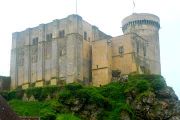
 Castle of William the Conqueror © T.Joly Castle of William the Conqueror © T.Joly
|
 Powerful square keep Powerful square keep
The two other ones are older and have a square shape typical of the Anglo Norman keeps associating military function with residential purpose. Dating back to 1137, the largest one was built by William the Conqueror’s son, Henry I Beauclerc, and is said to have been inspired by the Tower of London. It is dotted with a curious grey concrete forebuilding being the result of a very controversial restoration done in 1996. Fortunately, the inside works made by the restorers are much more successful. Rooms usually have plain walls and little furniture but visitors are handed an iPad like tablet allowing them to see how the interior decoration once looked like. For that, they just have to point it to the medallions located in each room and the world of the past swells up unto the screen.
 Augmented reality Augmented reality
Then, by clicking on some objects or on the furniture they get additional information. In e few rooms the tablet also shows and explains frescos depicting medieval court life, hunting and war scenes. Lastly, it has a kind of dictionary on different objects, words and people of that time. Moreover, on various walls animated scenes of William’s life and those of his contemporaries are projected with commentaries and another room relates the conquest of England.
Outside, in the vast courtyards there are no medieval buildings anymore. However, a few binocular scopes standing on various locations offer 3D images showing how it looked like in the Middle Ages. Many of these buildings, including the castle chapel, were destroyed in 1944 during intense bombings that laid waste to the town.
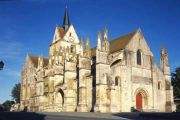
 ND de Guibray church © Damien Letotey ND de Guibray church © Damien Letotey
|
 Old churches Old churches
They took place during the Battle of the Falaise Pocket fought between August 12th and 21st when Allied troops encircled and defeated the bulk of German forces west of the river Seine. About 20 km away, a Memorial stands at Montormel where the decisive fighting took place.
As a result of the bombings, many ancient buildings have disappeared including most of the half-timbered houses, once numerous. Nevertheless, Falaise keeps a rich religious architectural heritage with four very old churches. Saint Laurent, that was built at the time of William the Conqueror, like Notre Dame de Guibray, a revered sanctuary that is one of the nicest Romanesque buildings in Normandy. Dating back to the 12th century, Saint Gervais is another fine example of Romanesque architecture but it also comprises Gothic parts such as a section of the nave and the choir. Lastly, the Trinity church was founded in the 9th century but nothing remains of the original building.
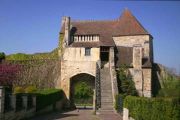
 Porte des Cordeliers © OT Pays de Falaise Porte des Cordeliers © OT Pays de Falaise
|
 Peaceful little valley Peaceful little valley
It is mainly of Gothic style, with a beautiful Renaissance portal, and inside don’t miss the capitals of the nave that are decorated with religious scenes. This church also has the earmark to be partially built over a street. Another monument survived WWII : the 18th century chateau de la Fresnaye. Surrounded by a beautiful park and situated in the Saint-Jean neighbourhood, it now serves as an exhibition centre.
Besides, there are a few 18th century private mansions scattered here and there around the old town that is still protected by large sections of its medieval ramparts. Almost 2 000 meters of walls are visible and they are punctuated by towers and entrance gates such as the beautiful Porte des Cordeliers. Built in the 13th century it leads to the Val d’Ante, a narrow little valley that was once home to numerous mills and tanneries. William the Conqueror’s parents, Robert the Magnificent and Herleva, the humble daughter of a tanner, met there.
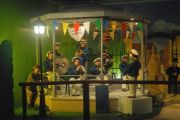
 Automatons Museum © T.Joly Automatons Museum © T.Joly
|
 Three hundred automatons Three hundred automatons
A fountain called “Fontaine d’Arlette” marks the exact spot where the two lovers first saw each other. With its old houses, its small river and a pond, the Val d’Ante has a countryside look quite unusual in a town and is a perfect place for a stroll. Another interesting sight in Falaise is the Automatons Museum (Musée des Automates). In a setting featuring streets from Paris in the early 20th century are displayed 300 automatons composing eight animated scenes created by famous cartoonists and draughtsmen such as Peyet, Dubout and Effel. They were made between 1925 and 1955 to adorn the windows of the Parisian big department stores at Christmas time. Two are very amusing. The oldest one that depicts an Afro American jazz band of the 20’s. And the one that shows cyclists lost in a farm and being attacked by pigs. A story that really happened during a Tour de France when jokers changed the signposts !!! Next door the Musée André Lemaitre displays ninety canvases of this local painters that enjoyed some fame in the second half of the 20th century.
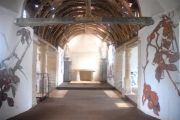
 Saint-Vigor chapel © T.Joly Saint-Vigor chapel © T.Joly
|
 Chapel with contemporary frescoes Chapel with contemporary frescoes
His landscapes of Normandy and his portraits are worth a visit. Another must-see is the chapel Saint-Vigor. Located 3 km away from the town, this 15th century chapel also known as the Apple Trees Chapel is famous for its frescoes created by Japanese artist Kyoji Takubo and representing the yearly cycle of apple trees in Normandy. Depicting large apple tree branches with leaves, flowers and fruits at different seasons, they were done using a specific technique. Kyoji Takubo indeed covered the walls with eight different colours of paint, the last of these being white. Then he worked on them with a stylus to reveal the underlying colours in order to create the frescoes. He also decided to remove the ceiling, leaving the roofing and timber apparent, and to replace a number of the standard flat tiles with glass tiles of the same size, some of them tinted blue, red or yellow. It took him ten years to complete the work and he lived in Falaise with all his family during the whole time.
August 20, 2013
Thierry Joly 

|
|
 |

|
 |



